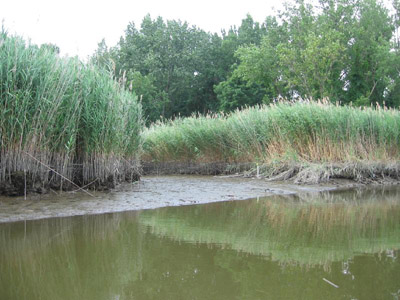
Phragmites australis (Common Reed) is a species complex of grasses, which occurs on every continent except Antarctica. One native subspecies. (P. a. subsp. americanus) is widespread across North America, while another, P. a. subsp. berlanderi is common on the Gulf Coast. However, a larger, densely growing and aggressive form of the reed began to spread in Northeastern North America in the 19th century. This form has been identified genetically as P. a. subsp. australis, possibly originating in the Middle East, but widespread in Eurasia. It was initially identified in North America as Phragmites australis Haplotype M (Saltonstall et al. 2002a). In the early 19th century, reports of Phragmites australis in developed Northeastern areas were rare. The date of invasion is uncertain, because of the possible presence of the native subspecies. Specimens of P. a. australis were collected along the Delaware River near Camden, New Jersey in 1877, in Connecticut in 1875. and Chesapeake Bay in 1885, Massachusetts, in 1915. This reed increased greatly in abundance in the Northeast through the 20th century, and expanded to more parts of the continent reaching Maine, North and South Carolina, and Maine, and the Great Lakes by 2002, with many scattered populations outside the Northeast, including Louisiana, San Francisco Bay, Humboldt Bay, and Puget Sound. Phragmites a. australis differs from P. a. americanus by growing in taller, more expansive and denser stands, greater tolerance of salinity (to 40 PSU), more rapid response to nutrients, and overall competitiveness. The subspecies differ in small details of leaf and stem morphology. Phragmites invasions of coastal wetlands have resulted in decreased plant diversity, food and habitat quality for some species. Because this plant has extensive rhizomes, eradication or control is difficult and can involve major disturbance. However, Phragmites plants also take up excess nutrients, deposit large quantities of detritus, elevating the level of marshes, and provide resistance to erosion and sea-level rise. At least 7 species of introduced insects of Eurasian origin feed on Phragmites in North American tidal wetlands, but these insects have not had apparent effects on the spread of this plant.